
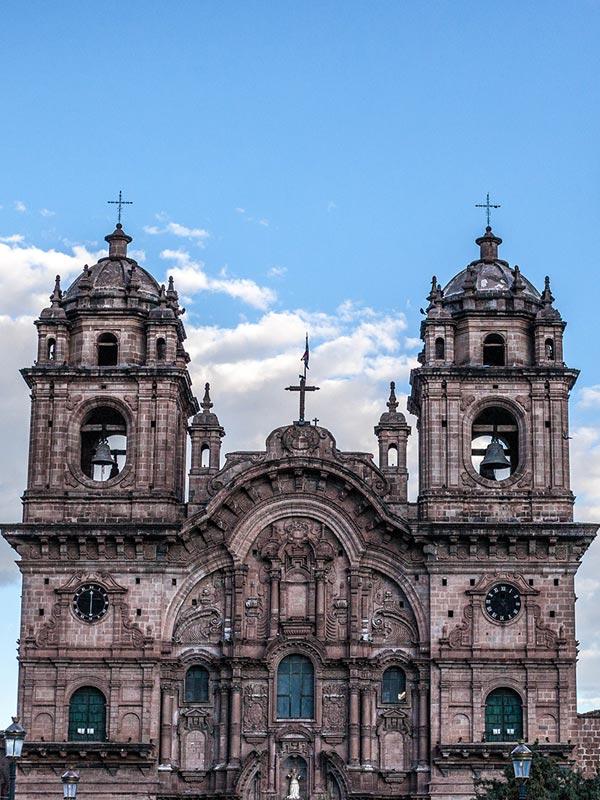
Long regarded as a mere stopover on the way to Machu Picchu, Cusco has become a tourist destination in its own right. UNESCO declared its historic center a World Heritage Site in 1983. Thanks in part to improved infrastructure and the help of promotional campaigns, Cusco now receives over a million visitors annually. With its cobblestone streets, old whitewashed buildings with classic blue accents, and artisan shops, the city is certainly imbued with charm.
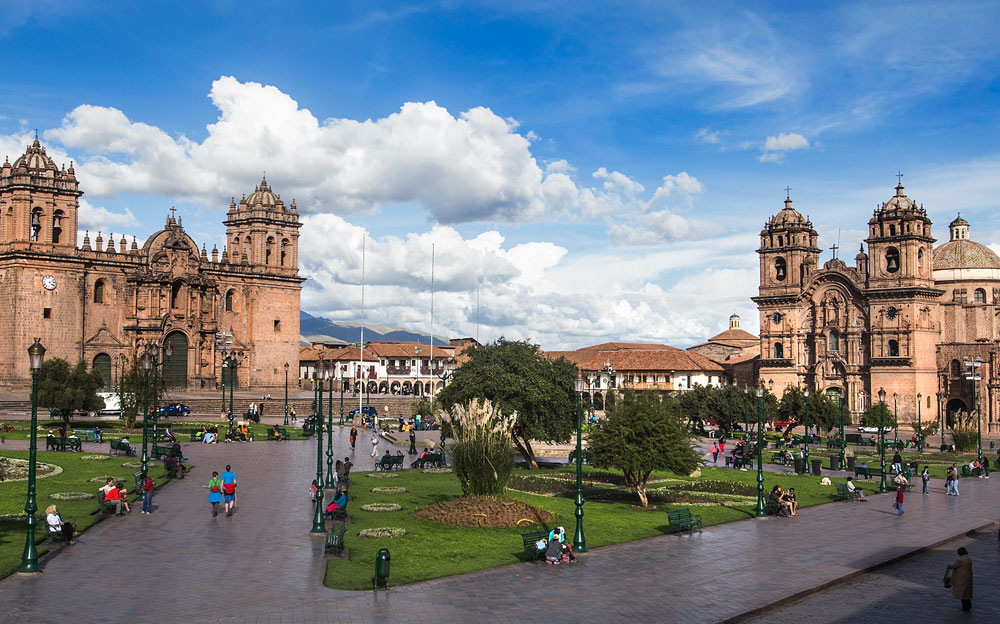
Most impressive, however, is Cusco’s momentous history. It was once the capital of the Inca Empire. Roads spreading out to the far reaches of the Incas’ territory, from present-day Columbia to Chile and Argentina, all lead back to Cusco. Following the Spanish conquest, Cusco became the intriguing melange of Inca and Spanish colonial architecture that can be seen today. Top all of this off with the larger-than-life ruins of Sacsayhuaman and other nearby sites, and discovery-minded visitors will be greatly rewarded.
But Cusco’s modern culture shouldn’t go unmentioned. Sophisticated restaurants and boutique hotels abound in this Andean city. Cusco is one of the few places in the world where it is possible to spend the night in a lavishly restored colonial monastery or casona. Enjoy the most luxurious services while soaking up the breathtaking location high in the Andes.
Cusco is located in the Andes mountain range in southern Peru. The Incas referred to Cusco as the “bellybutton of the world.” From above, the city appears carved out like a bowl among the surrounding mountains. The mountain landscape, coupled with impressive Inca and colonial structures, makes Cusco a beautiful tourist destination. However, this geography also means that the city has many steep hills, which can be tough to walk up when traveling from sea level.

Cusco is located within the Andes mountain range that passes through Peru. It has a subtropical highland climate. Being at such a high elevation, Cusco’s climate is characterized by dry and temperate weather. There are two defined seasons: dry and rainy. The dry season corresponds to its winter months and the rainy season to its summer. Temperatures can reach freezing point but rarely drop below inside the city. In the higher surrounding mountains, temperatures can drop significantly lower.
From May to September
The dry season corresponds to the Southern Hemisphere’s winter. However, because of Cusco’s location near the equator and high elevation, days are warm with strong sunshine. July and August are the driest months. Conversely, temperatures can plummet to freezing at night.
From November to March
Summertime in the Southern Hemisphere is also the rainy season in Cusco. Downpours are usually brief and infrequent. However, you can always expect light rain showers to interchange with clear skies throughout the day. The wettest months are January and February. Cloud cover means nights are warmer.
April & October The weather is quite variable as the season transitions. The days will be mostly a mix of sun and clouds that can be interrupted by brief rain showers.
The most often recommended time to visit Cusco is during the dry season. This is when visitors will experience the best weather. Although mountain weather can be variable, expect sunny skies most every day. However, the dry season corresponds with peak tourist season. So, although there is the prospect of great weather, travelers can also anticipate large crowds in the city.
For those that prefer to completely avoid crowds, traveling to Cusco during the rainy season is the best. Although rain showers are more frequent this time of year, it will not be constant. Clear skies are possible with a bit of patience.
Shoulder season months are also a good compromise between avoiding large crowds while also getting fair weather. Have a rain jacket or poncho ready in case of rain, but any showers will usually pass quickly.

The name Cusco is derived from the ancient Aymara name Qusqu (or Qosqo). Qusqu comes from the phrase “usqu wanka” which means “Rock of the owl.” According to the city’s foundational myth, Ayar Awqa, a man from the Aymara people, acquired wings and flew to the future city. When he arrived he turned to stone to mark possession of the land for his descendants. The name was then passed on to the Quechua people who would later live there.
When the Spanish arrived, they transliterated the name to “Cuzco.” This would later be more often spelled “Cusco” after pronunciation changes in both Spanish and Quechua.
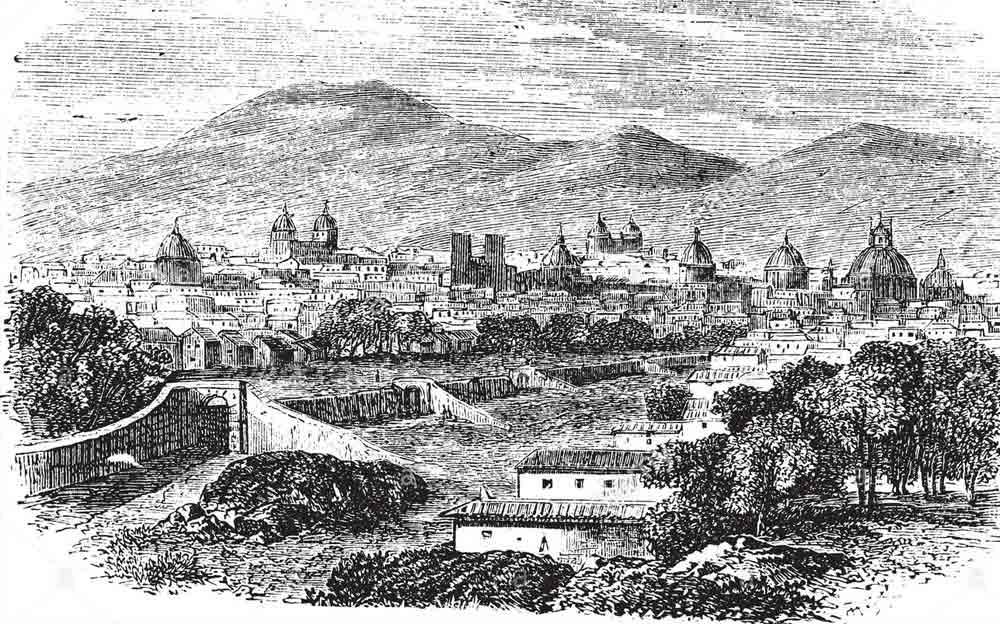
Cusco is famous as the capital of the Inca Empire (1438 - 1532), but its human history extends several centuries further back in time. The Wari culture established an outpost near Cusco between 600 and 1000 AD. Following this, the Killke culture became dominant in the region from 900 AD to 1200 AD. The Killke built irrigation systems and temples that the Incas would later adapt to their own needs. The archeological site Sacsayhuaman is an example of this adaptation.
The Incas rose to power beginning in the 1300s, but the real turning point came in 1438. Under the emperor Pachacuti, the Inca forces began a program of conquest and expansion. At its peak, the Inca Empire extended along western South America from modern-day Colombia down to Chile and Argentina. The territory became known as the Tawantinsuyu (Union of Four Quarters). Cusco itself was divided into four sections with a road leading out into each quarter of the empire: Chinchasuyu (northwest), Antisuyu (northeast), Kuntisuyu (southwest) and Qullasuyu (southeast).
Túpac Inca Yupanqui succeeded Pachacuti as ruler of the Inca Empire, later followed by Huayna Capac. After Huayna Capac’s death, his son Huáscar took over the throne in Cusco. However, during the Incan Civil War (1529-1532), his brother Atahualpa ultimately overthrew him. Atahualpa would only reign for a short time, as the Spanish were beginning their conquest.
Francisco Pizarro beat Atahualpa’s army and captured the Inca Emperor at the Battle of Cajamarca in December 1532. Atahualpa would be executed in July 1533. Later that year, Pizarro marched his forces into Cusco. The conquistadors defeated the remaining Inca army and plundered the city.
Many Incan temples and palaces were destroyed. The Spaniards then constructed on top of the Incan foundations in their own colonial style. The Cusco Cathedral was one such structure, built between 1560 and 1654. Vincente de Valverde became the Bishop of Cusco. From then on, the city was the center for colonization and evangelization in the Andean region.

For a powerful re-telling of the defeat of the Inca Empire, we recommend The Last Days of the Incas. This historic account was written by our very own Peru Travel Specialist Kim MacQuarrie.
The discovery of Machu Picchu in 1911 was most relevant for the history of Cusco. Machu Picchu’s exploration gradually transformed the former Inca capital into a hub for travelers from all over the world. UNESCO recognized the historic center of Cusco as a World Heritage Site in 1983. The Peruvian government has greatly developed local tourism in the last few decades. As a result of this, Cusco’s own historic sites have seen increasing numbers of tourists.
Centuries after the Incas made Cusco their capital, the Plaza de Armas remains the heart of the city. The magnificent colonial structures of the Cathedral and the Jesuit church stand watch over the square. In the center of the square, surrounded by well-kept trees and flowers, is a colonial-era fountain. In 2011, the city of Cusco installed the Inca statue atop the fountain. The statue is intended to remind visitors of the city’s Incan heritage beneath its colonial architecture.
Head here for unbeatable people-watching and to marvel at monumental architecture from the city’s distinct periods.
The Cathedral Basilica of the Assumption of the Virgin is more commonly known as Cusco Cathedral. It is an impressive example of Renaissance-Gothic architecture of the Spanish colonial period. It is an important monument for its religious following. Moreover, it is a center for historical art. Inside the Cathedral are exemplary paintings from the Cusco School of Art. One famous piece is Marcos Zapata’s Last Supper, which features traditional roasted cuy (guinea pig) as the main dish.
Visitors are sure to marvel at the gigantesque stone walls of this impressive ruin. Along with the historic center of Cusco, UNESCO recognized Sacsayhuaman as a World Heritage site in 1983. The Incas built on top of a preexisting Killke structure to create a ceremonial fortress. Like other Incan structures, Sacsayhuaman exhibits the ashlar technique with impeccably cut stones, expertly fitted together without the need for mortar.
Visit Santo Domingo Church to see what remains of Coricancha, the Inca’s principal Temple of the Sun. In Quechua, Coricancha translates to “Golden Temple,” which is extremely fitting for a building dedicated to the sun god Inti. During the Spanish Conquest, the temple was destroyed and the Spaniards built the Santo Domingo Convent over the foundations. The structure is a quintessential example of crossed architectural styles. Inside, enjoy the quiet courtyard and the variety of colonial and modern artwork on display.
Navigate to Hatunrumiyoc, a narrow, ancient alley, to marvel at an impressive example of Inca stone craftsmanship. One would think that the Incas’ ashlar technique knew no bounds. Today, the twelve angle stone makes up the lower wall of the Archbishop of Cusco’s palace. Snap a picture in front of this magnificent stonework, complete with a man dressed in a traditional Inca costume.
Explore the bohemian quarter of Cusco, home to the city’s finest artisans since Inca times. Although it lies only a few blocks from the Plaza de Armas, reaching San Blas is quite the uphill climb. Once atop the cuesta San Blas, or San Blas hill, admire beautiful views over the historic center. Check out artisan workshops and boutiques, and take a peek at the San Blas Temple, Cusco’s oldest parish.
Hike from the city center to the base of this giant white statue for stunning panoramic views over Cusco. The 26-foot-tall structure was sculpted by native Cusco artist Francisco Olazo Allende. Legend has it that earth from all four corners of the Inca Empire was brought to the hill, making it a sacred place to the Incas. From this legendary site, the colossal image of Christ opens his protecting arms to the people of Cusco below.
The San Pedro Market is a hub for campesinos from the surrounding hills to sell their products. It is often frequented by locals doing their grocery shopping. Browse the aisles of this traditional market filled with vendors selling stacks of fruits, fresh flowers, intricately woven textiles, and more. You can also find souvenirs at many of the stands.
Glimpse artifacts that demonstrate the diversity of Peruvian history and culture. The 400 pieces on display are part of the collection of the world-renown Larco Museum in Lima. The artifacts are divided among 10 rooms based on specific themes, such as geographic regions and materials. The MAP also boasts an on-site restaurant, MAP Café, where you can try exquisitely prepared local dishes.
Chocolate lovers flock to this museum to participate in chocolate-making workshops and sip on uniquely flavored hot chocolate. Plus there’s a sweeping view from the café balcony. Try the bean-to-bar workshop and learn about the cultivation and production of chocolate before crafting your own flavorful bars. If you’re just passing through, stop to buy some specialty chocolate products.
A trip from Cusco to Rainbow Mountain is a perfect option for hiking enthusiasts. From the viewpoint you can see the spectacular range of Peru’s rainbow mountains.
Pick up is usually before dawn, around 4 am, and the drive takes approximately 3.5 hours. The trailhead is located at 14,189 ft above sea level (4,326 m), while the summit lies at 17,060 ft (5,200 m). It takes 4 hours on average to reach the top of the trail. The gradient is not particularly steep, but the elevation is enough to make even those in the best of shape feel winded. To many adventurers’ relief, the downhill hike back to the trailhead is faster. After a long day of hiking, you’ll arrive at your hotel around dinnertime for some well-earned relaxation.
Rise early and head out to the trailhead for Lake Humantay, Cusco’s beautiful emerald lake. The trailhead is already high, situated at 12,630 feet (3,850 m) above sea level. The highest point, though, will push you to even loftier heights, at 13,780 feet (4200 m). However, the view at the top is well worth it. The minerals of the surrounding glaciers bestow the lake with a vivid turquoise glow. Humantay Lake is truly a jewel among the snow capped mountains of the Vilcabamba range.
Conveniently located on the way to Machu Picchu, the Sacred Valley is home to a number of imposing Inca ruins worth visiting. Framed by an alluring mountain landscape, it’s also the perfect place to slow down for a day or two to appreciate the natural surroundings and clear, starry nights.
Depending on which sites you plan on visiting, going from Cusco to the Sacred Valley takes from 1.5 to 2 hours. Popular sites include the Pisac ruins and market, the Moray ruins, the Maras salt pans, and the Ollantaytambo Fortress.
For a more adventurous experience in the Sacred Valley, set out on a river rafting excursion. There are several places to go white water rafting on the Urubamba River, which meanders through the heart of the Sacred Valley. It is possible to find rapids as easy as Category I up to Category III during the rainy season.
Equestrian enthusiasts will find several horseback riding trails just outside of Cusco, as well as throughout the Sacred Valley. This is one of the best ways to visit off-the-beaten-path ruins near Cusco. Options near Cusco include El Balcon del Diablo (Devil’s Balcony), the Kusilluchayoc archeological site, and the Moon Temple.
Keep in mind that Peruvian horses—known as the Peruvian Paso—are smaller than those in North America and Europe. For this reason, riding companies often impose a weight limit of 187 lbs (85 kg).
Neighbouring the Sacred Valley, the Southern Valley outside of Cusco also holds some spectacular archeological sites. The ruins included are Tipon, Pikillacta, and the Andahuaylillas chapel (often called the “Sistine Chapel of the Andes”). You can also visit many of these sites en route to Puno and Lake Titicaca.
Throughout the year it is possible to witness the remarkable fusion of Catholic and Andean traditions in Cusco. Dotted across the calendar are numerous processions dedicated to various patron saints. However, the entire city is sure to turn out for the holidays listed below.
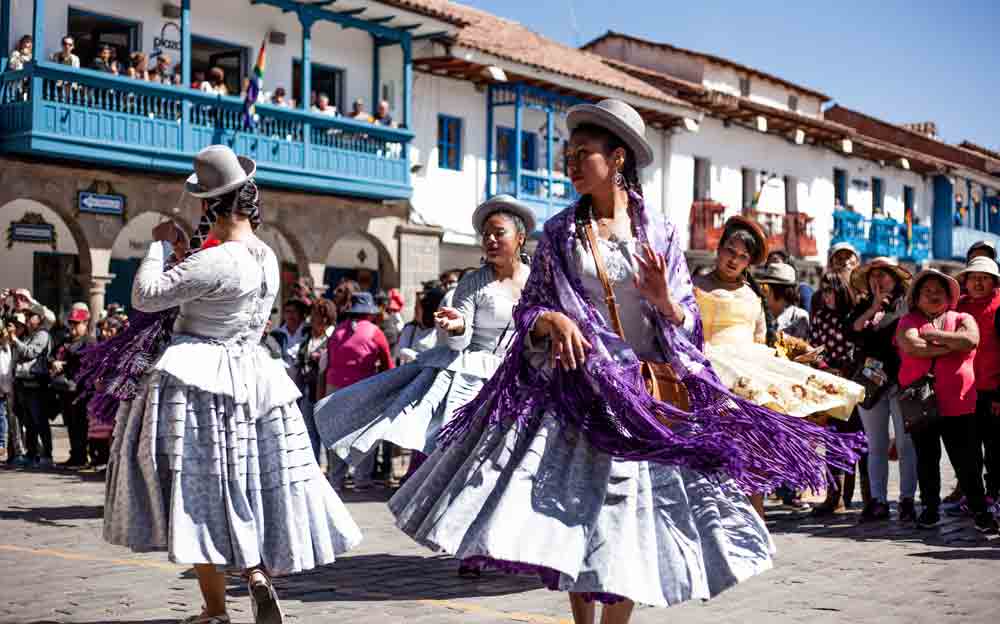
New Year’s Eve going into New Year’s Day is one of the most lively times of the year in Cusco. The Plaza de Armas packs out with locals and tourists alike. Many people attend decked out in yellow hats and clothing, intended to bring good luck in the coming year. Live music sounds throughout the square and fireworks light up the city from the sky above.
Holy Week festivities begin on Monday with a procession for Taytacha Timplures in Quechua, “Senor de Los Temblores” in Spanish. (“Lord of Earthquakes” in English). Other important dates in the week are Holy Tuesday, Holy Thursday, and, of course, Easter Sunday. Several processions wind through Cusco’s streets, with many ending at the doors of the Cathedral. Other religious temples also fill with churchgoers.
Corpus Christi is celebrated nine weeks after Holy Thursday. At noon, a procession with images of various saints passes through the cobblestone streets of Cusco to the Cathedral. A week later the saints return to their home parishes throughout the city.

Modern-day Inti Raymi is a recreation of the Inti Raymi festival of the Inca Empire. This festival would unite representatives of the Tawantinsuyo, the four quarters of the empire. Inti Raymi translates to “Sun Festival” in Quechua and celebrates the winter solstice. The three stages take place at Coricancha, the Plaza de Armas, and Sacsayhuaman.
The 28th of July celebrates Peru’s independence from Spain and is observed with patriotic zeal throughout the country. For the month of July, every house and building in Peru is adorned with the national red and white flag. Celebrations in Cusco include parades through the Plaza de Armas and ample amounts of fireworks.
A Christmas Market is set up in the Plaza de Armas in the days leading up to Christmas. On Christmas Eve and Day, most shops are closed and local churches overflow with worshippers. A beautiful nativity scene is also set up outside Coricancha. Despite the fervent religious tone of most of the celebrations, expect an uplifting show of fireworks on Christmas Eve.
Cusco hotels range from luxuriously converted colonial casonas to traditionally decorated boutique hotels. Whatever style and service you are looking for, we have expert recommendations. Below are our Top Picks for the best hotels in Cusco for each star category. Find more spectacular hotel options on our Cusco hotel page.
When visiting somewhere with cuisine as impressive as Peru’s, you want to be sure to dig into a worthy dish. The best restaurants in Cusco know how to elevate typical Peruvian dishes. Expect to feast upon fresh local ingredients, prepared using traditional culinary techniques. Here is a list of Cusco restaurants that will surely tempt your tastebuds.
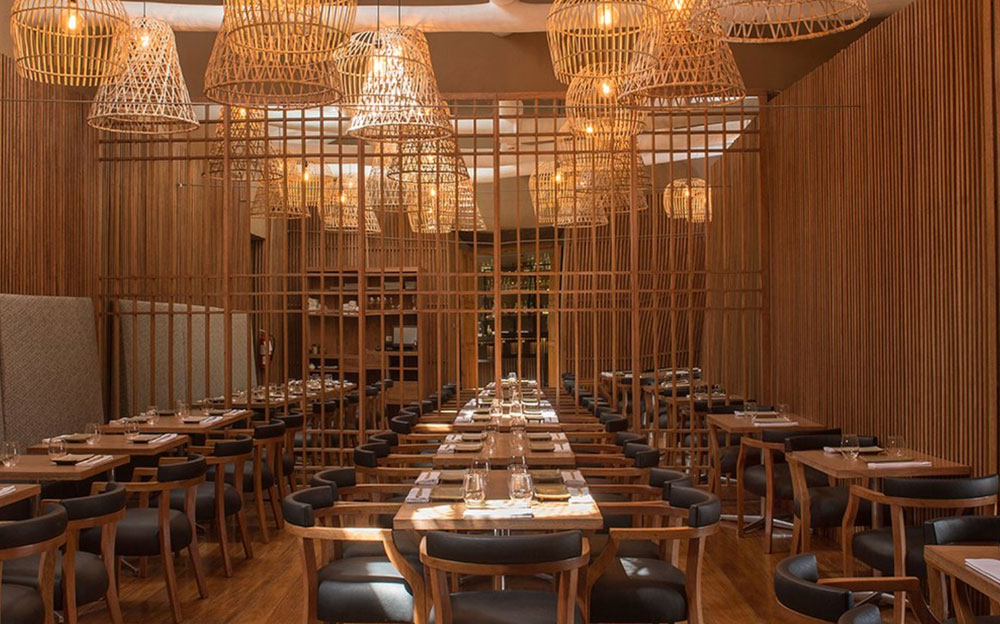
Andean and Creole dishes slow-cooked and flavored with native ingredients. Hearty main dishes include grilled alpaca topped with fresh mango chutney, and ají de gallina. Rooftop tables overlook Cusco.
Calle Palacio 121
Great for groups of diners with diverse tastes. Choose from traditional Peruvian dishes like seco de cordero (slow-cooked herbed lamb stew). There are also international favorites, such as fresh baked pizza or calzones. Specialties include baked guinea pig and pachamanca (meat and vegetables prepared in an in-ground oven). However, be sure to reserve these at least 24 hours in advance via the restaurant website.
Plaza San Blas 120
The place to go for ceviche, a full sushi bar, and delicious pisco cocktails. On top of that, Limo also offers non-seafood Peruvian favorites. Dig in to arroz chaufa (fried rice with a Peruvian spin), cuy (guinea pig), alpaca steak, or pork adobo. Make a reservation and request a table by the wide windows with views of the Plaza de Armas.
Portal de Carnes 236, 2nd floor
The Cusco restaurant of the internationally renowned Peruvian chef Gaston Acurio. Local ingredients form the basis of a menu organized by geographical divisions. Open for lunch and dinner, Chicha Cusco is a must try for any food fanatic.
Plaza Regocijo 261
Featuring modern takes on traditional Peruvian cooking, Café Morena consistently garners rave reviews. This is a great place to try classic dishes like chicharrón (deep fried pork) and lomo saltado. As well as fresh juices and smoothies.
Plateros 348-B
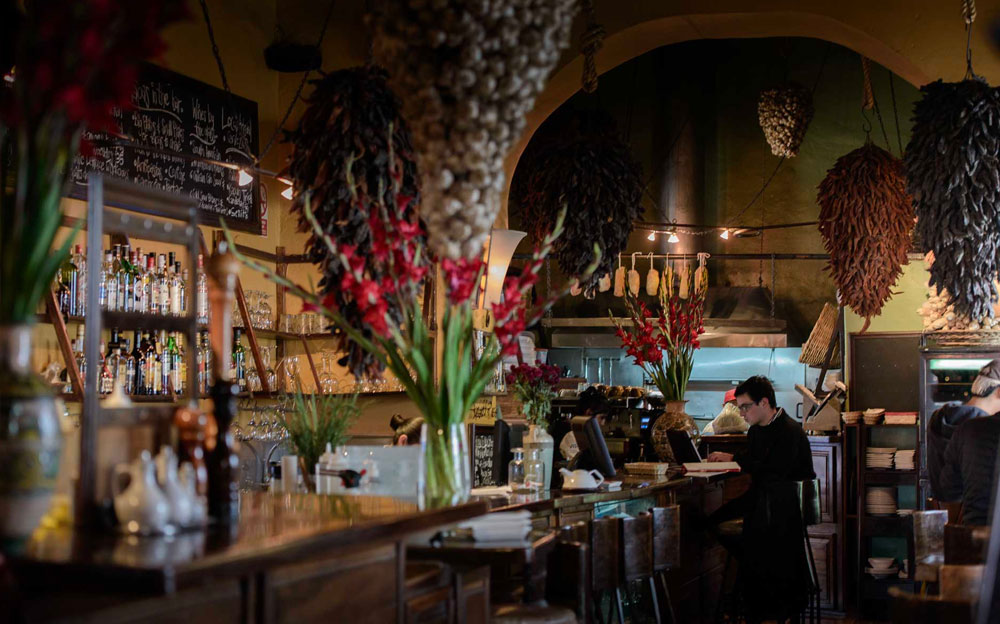
Above and beyond the standard pizzerias found on every street corner of Cusco. The focus here is on made-to-order wood-fired pizzas with a selection of gourmet toppings. Pair with your choice of wine, craft beer, or non-alcoholic drinks.
Herrajes 138
Peruvian and international dishes with Italian touches shape the menu at this renowned restaurant and tapas bar. Reservations are a must. Don’t miss the lamb ragu and the causa de cuy.
Calle Triunfo 393, 2nd floor
Dive into a menu of Mediterranean flavors using local ingredients with options ranging from seafood to thin crust pizzas. Pair your meal with a glass of wine from the South American focused selection.
Calle Ruinas 465
Order from a farm-to-table menu that is equal parts Peruvian and international. With options like zapallo (pumpkin) soup, lomo (beef tenderloin) in red wine sauce served with Spätzle (German pasta), and crêpes.
Cuesta San Blas 525, 2nd floor
Always buzzing with customers thanks to an excellent menu that caters to Western tastes. Go for all-day breakfasts, huge sandwiches, and hearty salads. Other tasty treats include stir-fries and burgers.
Choquechaka 509
Vegetarian-friendly but with a menu of enticing chicken, fish, and alpaca options too. All dishes are made with fresh organic ingredients. Located on the second floor of a colonial building, the best seats have views of the Plaza de Armas.
Santa Catalina Angosta 135, 2nd floor

Open for breakfast, lunch, and dinner, Green Point is a go-to for vegetarian and vegan diners. The daily set meal is an inexpensive, filling, and delicious option.
Carmen Bajo 234, San Blas
The younger sibling of Green Point serves up 100% vegan goodness. Enjoy your meal in the shaded outdoor patio.
San Francisco Plaza 310
A cozy 10-table restaurant with a menu that appeals to vegetarians and meat-eaters alike. Dishes are prepared with fresh ingredients from Sacred Valley farms.
Calle Resbalosa 410
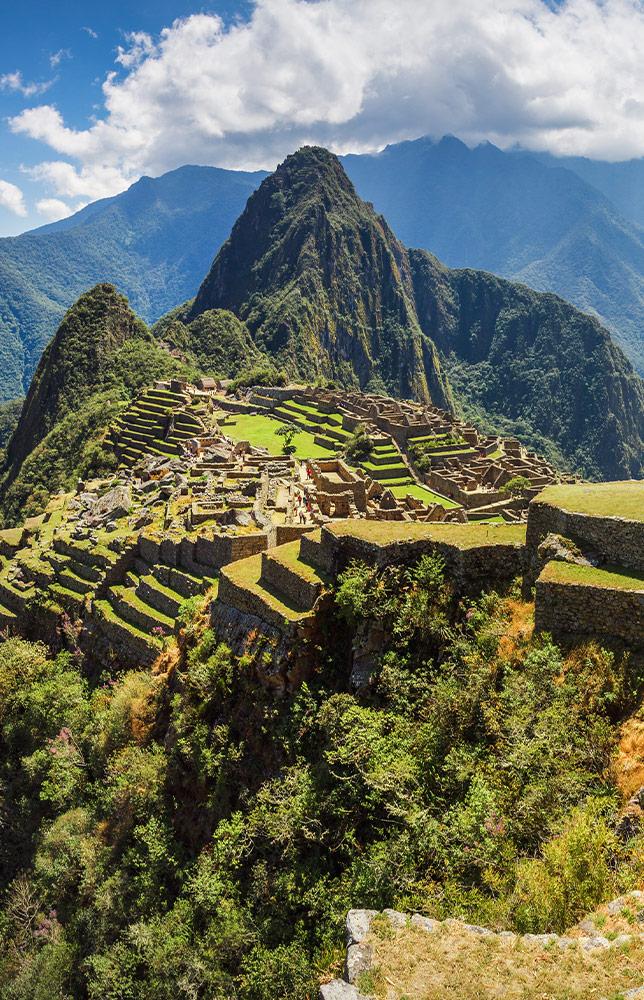
12 days
Cusco, Lima, Machu Picchu, Puno & Lake Titicaca, Sacred Valley, Arequipa, Colca Canyon
Most international flights arrive in Lima, the capital city of Peru. Flying is the most common and efficient way to get to Cusco from Lima. Flights between the two cities run multiple times a day with various airlines. However, LATAM has the most frequent number of daily flights from Lima to Cusco (as well as returning flights from Cusco to Lima). It is also the most reliable company.
Flights are also the fastest way to get to Cusco from Arequipa and Puno (Lake Titicaca).
CUZ
There are several reputable bus companies, such as Cruz del Sur and Civa, that make the journey from Lima to Cusco (as well as from other Peruvian cities). Although cheap, it is not an efficient way to get there if you have limited time in Peru. The drive will take at least 22 hours. You will also have few stops along the way to stretch your legs on a commercial bus.
*It is not recommended to take a non-reputable bus.
Tourist buses are available for escorted tours. This is a fine option if visiting Peru on a budget. However, it is only recommended if you don’t mind being with a large group of travelers over the course of your journey.
Although it is possible to drive from Lima to Cusco, it is not at all recommended. Firstly, it will take at least 22 hours to get there, similar to the bus. More importantly, unless you have experience driving in developing countries, it is not very safe. The roads through the Andes are winding and not always in the best condition. Plus, other drivers can be aggressive, especially in cities like Lima and Cusco.
*There is no train from Lima to Cusco.
The most common way to get to the ancient Inca citadel is the train from Cusco to Machu Picchu. The Cusco train station is located just outside the city in the village of Poroy. During the dry season, the train goes directly from Cusco to Aguas Calientes. However, for part of the rainy season from January through April, there is a bi-modal transportation service. During this time, you will need to take private transportation or a bus from Cusco to Ollantaytambo. From the Ollantaytambo train station, you will then take a train for the remaining distance to Aguas Calientes.
From Aguas Calientes, you will take a bus up a switchback road, dropping you off at the ruins entrance. Walking is not recommended as you will have to cross the same road as the bus.
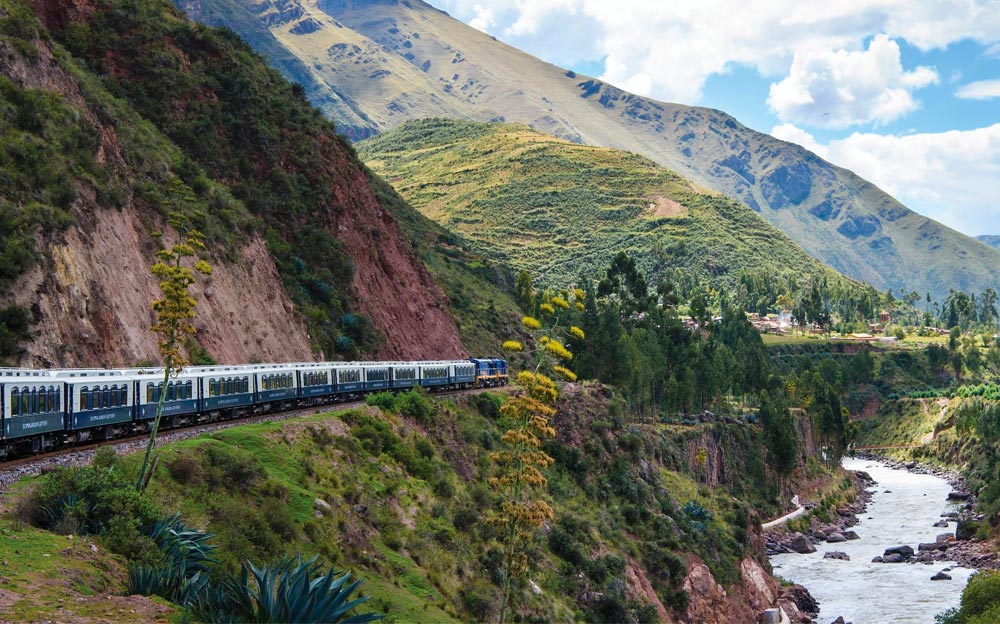
Another popular way to get to Machu Picchu is via a trek. There are several trails that wind through the Sacred Valley and end at Machu Picchu. The most well-known trek is the Inca Trail. The classic Inca Trail is 4 days long. There is also a shorter, full-day version that follows the last leg of the trail.
The Cusco airport is called Velasco Astete International airport, airport code CUZ. It is located within the city limits to the southeast of the historic center. It takes 10 to 30 minutes to drive from the airport to the center, depending on traffic.
If traveling with Inca Expert Travel:
An English-speaking representative from Inca Expert Travel will be waiting for you. Exit the baggage claim area onto the sidewalk in front of the parking lot. The representative will be to the left holding a sign with your last name (or group name) on it.
Independent travelers:
You can arrange your own transportation from the airport. We recommend using one of the licensed taxi companies inside the airport.
If traveling from sea level to Cusco (11,150 ft) you should be prepared for possible altitude sickness. Most visitors experience only minor symptoms (headache, lethargy, nausea) which usually ease within 1-2 days. If you’re planning to hike to higher elevations, allow for 2-3 days to acclimate in Cusco beforehand.
Take it easy as your body adjusts to the high elevation. Also, drink plenty of water to prevent dehydration. Drink bottled water or filtered water only. Tap water is not safe to drink anywhere in Peru. For bottled water, “agua sin gas” is mineral water, and “agua con gas” is carbonated water. Both are available for sale at kiosks and small markets all over Cusco. Ice is typically made from filtered water and safe to consume.
Cusco is one of the safest cities in Peru. However, you should always take standard precautions when traveling to any new city. Pay attention to your surroundings and keep your backpack or purse in sight and securely closed. Make sure cell phones and wallets remain out of sight when not in use. Any valuables and important documents, such as expensive jewelry and passports, can be kept in your hotel’s safe deposit box.
Most hotels are located in the streets surrounding Cusco’s Plaza de Armas, San Blas, and Santa Ana neighborhood. Tourist sites, museums, restaurants, and nightlife are also concentrated in these areas. As it’s such a small area, it’s easy to get around Cusco on foot. San Blas and Santa Ana are situated atop fairly steep hills, which can be tough to climb with the altitude. However, it still won’t take more than 15-20 minutes to walk from the Plaza de Armas up to these neighborhoods.
It is also easy to hike to the ruins on the outskirts of the city. The walk should take roughly 30-40 minutes if starting in the Plaza de Armas. However, you can also reach these sites by taxi in 5-15 minutes, depending on traffic. In this case, it is recommended that you have your hotel call a reputable taxi company for you.
The currency in Peru is the Nuevo Sol, or more commonly referred to as soles. It is recommended to carry soles with you for restaurants, taxis, or souvenirs. It is also important to carry smaller bills and coins. Small vendors may not have enough change for large bills (i.e., bills of 50, 100, or 200 soles). Apart from small shops and street vendors, many establishments accept credit cards, such as hotels, restaurants, and tour agencies. As of August 2020, 1 USD = 3.50 soles.
Money exchange offices and ATMs are located throughout Cusco’s historic center. When paying in USD or exchanging, make sure that you have bills in excellent condition. Bills with any sort of blemishes or tears will not be accepted. Be sure to inform your bank(s) of your upcoming travels and check which withdrawal fees apply.
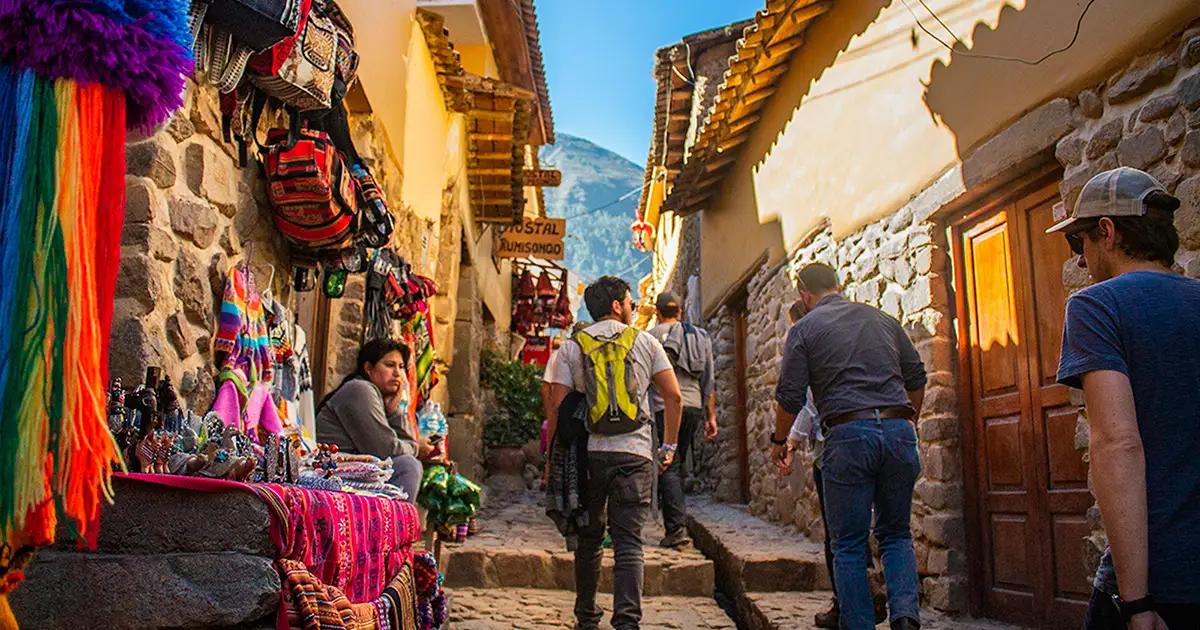
Discover the incredible things to do in Cusco, the historic heart of Peru. Once the capital of the Inca Empire, Cusco is now a treasure trove of Incan and colonial architecture, blended seamlessly with modern culture.